
Celebrate ten years of Urban Omnibus and support ten more years of fresh, independent perspectives on citymaking with a donation today!
Celebrate ten years of Urban Omnibus and support ten more years of fresh, independent perspectives on citymaking with a donation today!
Brooklyn’s Prospect Park is well known for its bountiful farmers market, avid runners, consistent drum circle, and the waves of picnics and barbecues that dot its fields in summertime. A closer look reveals multiple histories hidden in plain site: a private, active Quaker cemetery dating from the 1820s, an 18th century farm house whose inhabitants gave the nearby neighborhood of Prospect Lefferts Gardens a third of its name. Even less conspicuous are markers of the Battle of Brooklyn, a pivotal moment in the war for American independence that occurred 238 years ago today on land that is now part of the park’s East Drive.
Writers Ben Nadler and Oksana Mironova have uncovered how the subtlety of the monuments to the battle is both intentional and contentious. In their 1865 design for the park, landscape architects Frederick Law Olmsted and Calvert Vaux chose to maintain what came to be known as Battle Pass as a memorial to the many American soldiers that fell under a British onslaught. But citizens’ groups over time have viewed preservation of the site as open space as inadequate, erecting small plaques and monuments to embed the event more overtly in public memory. Delving into the history of a piece of public land and a significant moment in public history, Mironova and Nadler explore different notions of how we memorialize tragedy and question the ways we imbue our public sphere with historical memory in an age of waning public budgets and increasing privatization. —J.T.
“It is true that the people of Brooklyn own the land in Prospect Park, making the whole park a fitting and permanent monument to Brooklyn’s great historic event.”
Charles M. Higgins, 1916
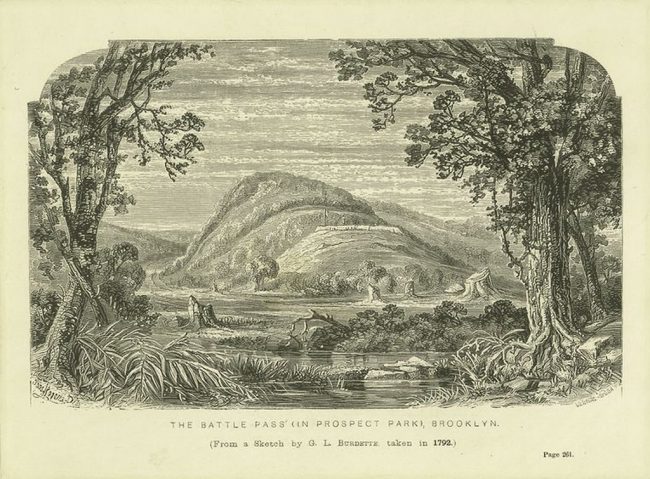
Drawing of Battle Pass | Image via NYPL
Today marks the 238th anniversary of the Battle of Brooklyn, the largest single battle of the American Revolution and the first under George Washington’s direct command. The British invasion of the scattered towns of southwestern Long Island was of national as well as local importance, helping form Brooklyn’s identity as a coherent entity, first a city and then a borough. The battle was a violent defeat for the Continental Army, but Brooklyn’s unique and critical role in delaying the British invasion of Manhattan — and the entire fledging republic — had long-term ramifications. The mass violence inflicted a wound that Brooklyn has continued to process in the intervening centuries. What was perhaps the bloodiest and most tragic site of the battle is now known as Battle Pass, and sits in the northeast corner of Prospect Park in a wooded area between the zoo and the southern end of Long Meadow. Spanning two small hills and a 50-yard stretch that passes between them, marked by a few modest memorials and plaques, Battle Pass is preserved largely as it was at the time.[1] Today, when commemorative spaces more often take the shape of costly, monumental, highly visible memorials, the subtle commemoration found at Battle Pass offers an opportunity to challenge our assumptions of what it means to remember collectively and publicly.
Of course, the site’s surroundings have changed since 1776. Flatbush Avenue has always been an important arterial road, but in colonial times it was a narrow dirt cart path. When the avenue became a modern, paved road it was redirected 200 yards to the east, where it forms the park’s boundary and connects to the street grid. The original section of Flatbush Avenue that ran through the pass is now incorporated into the park’s East Drive, popular with cyclists and joggers. The area was cleared farmland at the time of the battle, not the green parkland of today. A small knoll behind Redoubt Hill — the western hill, which is the higher of the two and the site of the American cannon position — was removed during the construction of the park, but the hill itself maintains its original elevated topography. Few park goers climb the hills, but many stop on the drive to read the memorial plaques and take pictures.
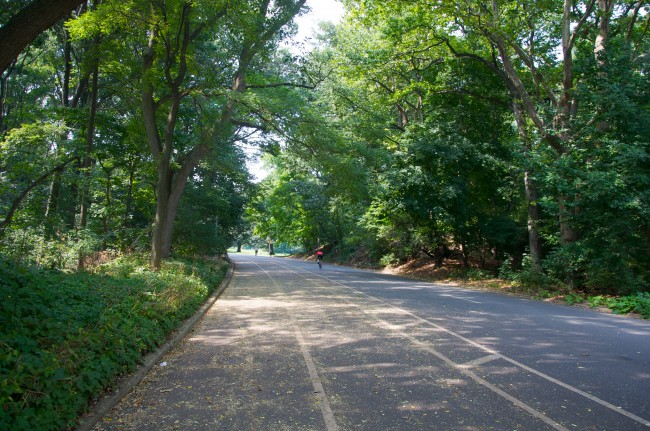
Contemporary Battle Pass | Photo by Carlos Quijano Jr.
The British military, led by the brothers Admiral and General Howe, invaded Long Island on August 22nd, 1776, landing in what are now the Brooklyn neighborhoods of Fort Hamilton and Dyker Heights. The invasion force consisted of around 20,000 troops, including English and Scottish soldiers, Hessian mercenaries, Tory militiamen from New York, and escaped slaves who worked as laborers for the British. The British forces met no resistance as they occupied the loyalist southern towns of New Utrecht, Gravesend, Flatbush, and Flatlands. Over the next four days, General Washington, who was based in Manhattan, sent reinforcements across the river to Generals Putnam and Sullivan in anticipation of the coming battle.
Early on August 27th, the British made their move. Odds were against the Americans from the beginning, in terms of organization, equipment, preparedness, and troop numbers. Some accounts place the American forces at eight or nine thousand — less than half the British total — while others estimate that the Americans were outnumbered three to one.[2]
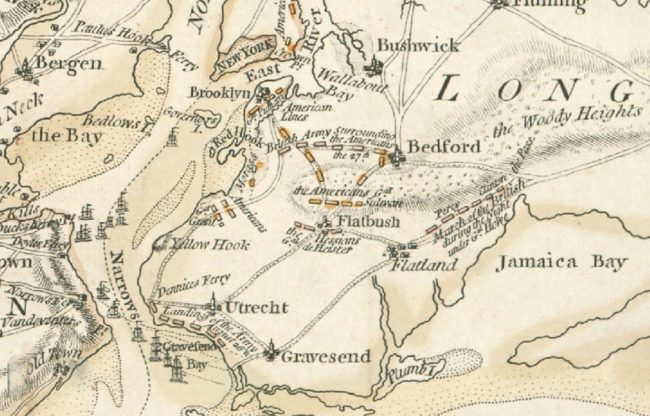
Detail of 1776 map detailing the Battle of Brooklyn | Image via NYPL
The British advanced in three columns, the largest of which captured the town of Bedford, now Bed-Stuy, after slipping through unguarded Jamaica Pass. Another met American troops in a watermelon patch near what is now Green-Wood Cemetery. Much of the subsequent fighting took place on Green-Wood’s Battle Hill, until the American’s were outflanked by the arrival of the force from Jamaica Pass. Forced to retreat a mile north, into what is now Park Slope, 400 Maryland militiamen took refuge in the Vechte-Cortelyou House — also known as the Old Stone House — which they defended until losing half their men.
The central column marched up Flatbush Avenue, with the goal of crossing through Battle Pass, then known as Flatbush Pass. General Sullivan and his 1,300 troops, armed with long rifles and cannons, took up position on the two hills that form the pass, and barricaded the low pass itself with debris, including the Dongan Oak, a large white oak that had delineated the border between the towns of Brooklyn and Flatbush before it was felled by the troops. It was a relatively strong position; the narrow road passing between two elevated points allowed the Americans to hold the higher ground above the advancing Red Coats.
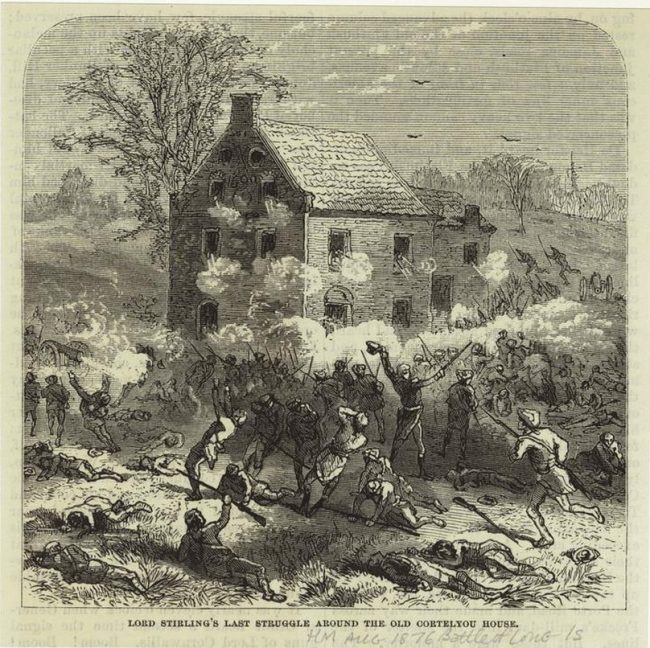
1876 drawing of “Lord Stirling’s Last Struggle around the Old Cortelyou House” | Image via NYPL
Sullivan’s men managed to hold their position against the army of 5,000 trained soldiers for much of the morning but were eventually overwhelmed by the sheer numbers of attackers. Of those not killed in the fighting, some of the Americans managed to flee north and regroup, but many were taken prisoner and summarily murdered.
The Battle of Brooklyn was undoubtedly a defeat for the Americans, despite their valiant fighting and spilled blood, particularly at Battle Hill, the Old Stone House, and Battle Pass. However, the fierce American resistance, and General Howe’s decision not to pursue the Americans into fortified Brooklyn Heights, allowed the main American military force to escape to Manhattan, which contributed to the ultimate American victory seven years later. According to Dr. Julie Golia of the Brooklyn Historical Society, “The preservation of the Army allowed Brooklynites and New Yorkers to see themselves as central in the continuation of the Revolution after a spectacular defeat.”
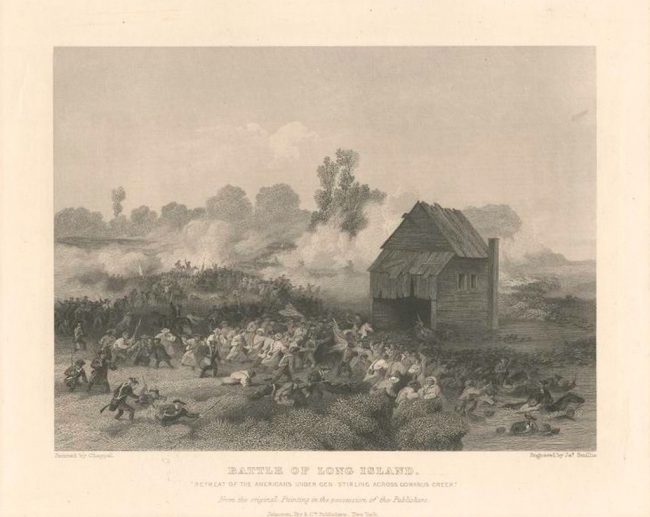
1860 drawing of the “Retreat of the Americans under Gen. Stirling across Gowanus Creek” | Image via NYPL
85 years after the Battle of Brooklyn, the recently incorporated City of Brooklyn was urbanizing rapidly thanks to blossoming waterfront industries and regular ferry service across the East River. Exploding population growth, new ideas about long-range planning and economic development, land speculation, and the success of Central Park all contributed to a push for a similarly grand park in Brooklyn.
In 1861, civil engineer Egbert Viele proposed a plan for Mount Prospect Park, which was accepted by the State-appointed Brooklyn Park Commission, led by business and civic leader James Stranahan. However, the Civil War halted the process, which gave the Commission time to reconsider. Stranahan then championed a new plan by landscape architects Calvert Vaux and Frederick Law Olmsted, who had designed Central Park together, which expanded the park and shifted it south to avoid being bisected by Flatbush Avenue.
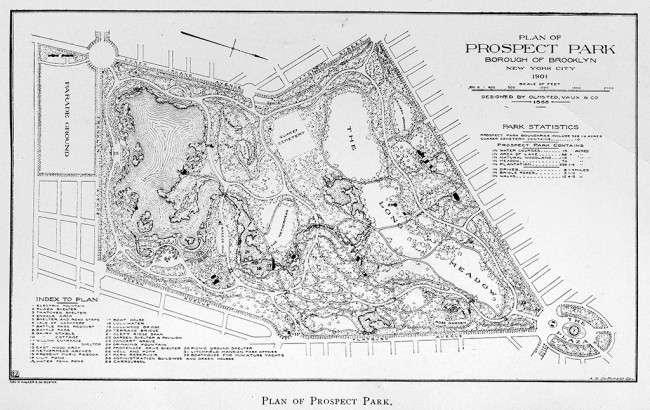
A 1901 map of Olmsted and Vaux’s Prospect Park | Image via Wikimedia
Olmsted and Vaux and the Commission were conscious of the commemorative value of the Battle Pass site. The history would have been difficult to ignore: according to the New York Times, “Human remains and musket balls were unearthed when the park’s East Drive was being built in 1866.” The 1867 Prospect Park Commissioners Report, published a year after the construction on the park began, vowed, “the battle pass, with the remains of the redoubt, will be carefully preserved and distinctly marked for the venerations of future generations.”
Olmsted and Vaux left the topography of Battle Pass relatively untouched; their approach to landscape architecture spurned the visual clutter of monuments in a space designated as an oasis from urban life. The responsibility to memorialize the battle fell on heritage organizations, such as the Daughters of the American Revolution, a group formed for the express purpose of preservation and collective remembrance of the Revolution. Battle Pass was marked by a non-descript plaque illustrating the Line of Defense, mounted on a boulder, donated by the Sons of the Revolution well after the park was completed. In 1895, the Maryland Society of the Sons of the American Revolution paid for a more substantial monument — a single column designed pro bono by Stanford White — in honor of the company of Maryland militiamen.
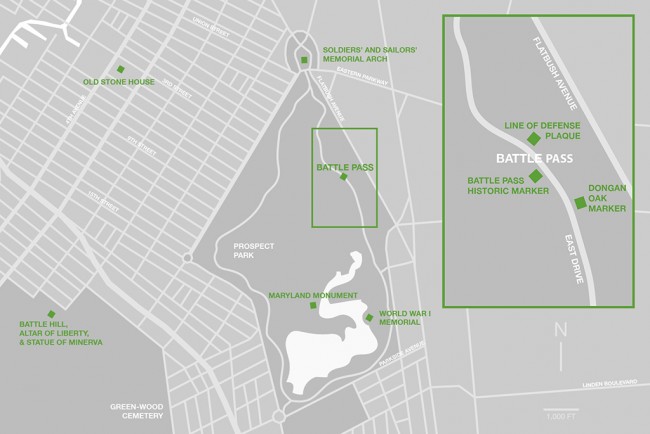
Click to enlarge | Map by Jonathan Tarleton
The Maryland Monument became an important place of remembrance of the Revolutionary War for Brooklynites, who gathered at the site on the battle’s anniversary. Still, the early 20th century saw a new drive to add a more substantial monument to the Battle Pass site itself. Letters to the editor and articles in the Brooklyn Eagle in the 1910s and ’20s demonstrated a frustration with the poor commemoration of the Battle of Brooklyn and called for a more fitting memorial. The Brooklyn chapter of the Daughters of the American Revolution began raising money for a complementary monument to the Line of Defense plaque. And in 1920, the wealthy businessman Charles Higgins unveiled an Altar of Liberty and a statue of Minerva on plots adjacent to his family tomb in Green-Wood Cemetery, situated on Battle Hill, to memorialize the battle.
After World War I, Battle Pass did get two new, modest monuments. In 1922, the St. Nicholas Society donated the Dongan Oak Monument, which recognized the oak that was cut down by Colonial soldiers and thrown across the road to impede the British advance. In 1929, the Daughters of the American Revolution added another plaque, detailing the events at Battle Pass.
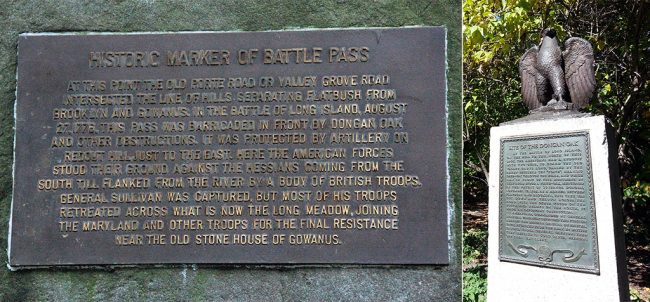
(L) Historic marker of Battle Pass and (R) Dongan Oak Marker | Photos by Chris Kreussling and Matt Green
In the 1920s, the Old Stone House became the central focus for a monument fitting of the Battle of Brooklyn. The Old Stone House was rebuilt, using some original material, relocated to a neighborhood park in Park Slope, and now functions as a museum and educational center about the battle. It could be argued that, as the Old Stone House is no longer in its original location, its direct connection to history has been severed. While an excavated and relocated site may be less meaningful than a preserved site, we would argue it is preferable to an obliterated one: many of the other sites of violence in New York City — such as the site of the Battle of Harlem Heights, or the sites of mass murder committed during the 1863 New York City Draft Riots — have been covered time and time again by commercial and residential development. What is perhaps more interesting about the Old Stone House, though, is the site’s focus on education, rather than simple memorial, which embodies a late 20th century shift in the understanding of how visitors might most productively interact with history.
Battle Pass and the Old Stone House offer two differing approaches to commemoration. The area around Prospect Park offers other examples as well, each reflective of its time. The Soldiers’ and Sailors’ Arch, the centerpiece of Grand Army Plaza just north of the park, was constructed in honor of the Civil War a quarter century after the Union Victory, when the trauma was still fresh, and was fully financed by the City of Brooklyn. The symmetrically ornamented Arch — the largest war memorial in Brooklyn, by far, reflected the widespread influence of the European Beaux Arts style on American architecture during the late 19th Century. The Arch marked the beginning of commemorations of battles fought far away from Brooklyn. In 1921, William H. Todd, a shipping magnate who profited greatly from the increased demand for ships during WWI, donated an ornate memorial to the Brooklyn men who perished in the Great War. In addition to a detailed statue of a doughboy encountering the Angel of Death, the memorial lists the men’s names. This memorial, while more local in scope, indicates the patriotic fervor and overt nationalist imagery of the time.
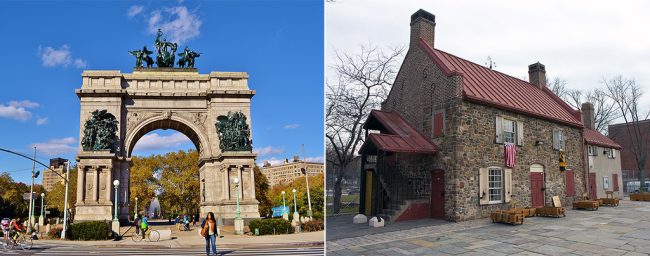
(L) The Soldiers’ and Sailors’ Arch in Grand Army Plaza and (R) the Old Stone House | Photos via Garrett Zeigler and Gigi NYC
As the 20th century progressed, the role of stewardship over Prospect Park in general, and its battle commemorations in particular, shifted multiple times. Robert Moses, who became Parks Commissioner in 1934, was particularly skilled in directing federal funding to large City-led public works projects. With the availability of New Deal funding through the Works Progress Administration in the late 1930s, the Maryland Monument, like the Old Stone House and others across the city, was restored after deteriorating during the Depression.
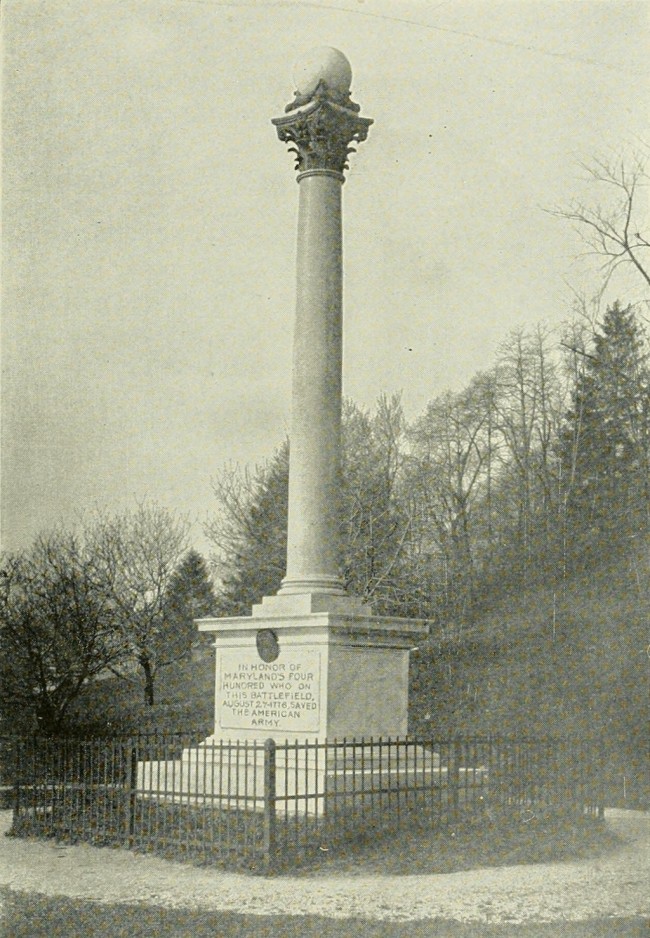
1903 photograph of the Maryland Monument | Photo via Internet Archive
But austerity measures adopted in the wake of the 1970s fiscal crisis hit the Parks Department hard. According to Jonathan Soffer’s Ed Koch and the Rebuilding of New York City, the Parks Department suffered the biggest budget cuts after the fiscal crisis, because it was primarily funded by City revenue. Further, Parks did not have the clout on par with other departments to challenge the defunding. Koch’s Parks Commissioner, Gordon Davis, believed that the introduction of public private partnerships would insulate parks from politically motivated funding fluctuations.
Thus, the stewardship role for Prospect Park, and other large parks throughout the city, passed into the hands of public-private partnerships like the Prospect Park Alliance. The Alliance restored the badly dilapidated Dongan Oak monument and twice replaced the bronze eagle, which had been lost to theft. In addition to general stewardship over the park, the Alliance has undertaken much larger development projects, such as the $74 million Lakeside project, which includes an ice-skating rink and a restaurant as well as a restoration of the World War I memorial. The process was led by the Citywide Monuments Conservation Program (CMCP), another public-private partnership, in cooperation with the Prospect Park Alliance and with funding from the United States Department of Housing and Urban Development.
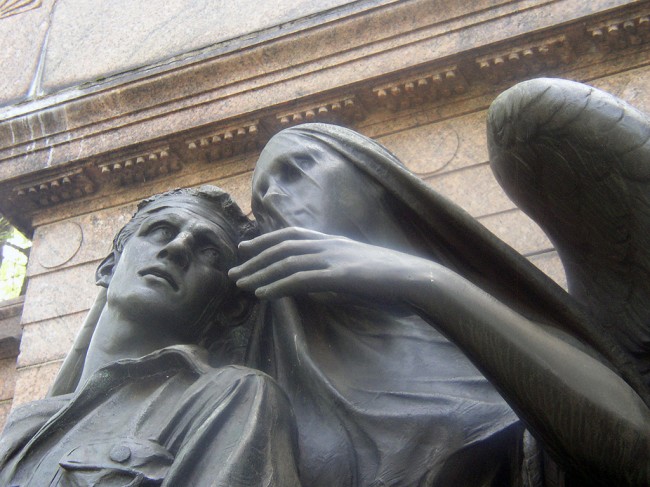
World War I Memorial | Photo by Benjamin Haas
As historical events fade further from memory with the passage of time, groups like the Prospect Park Alliance can serve an important role in preserving and maintaining memorials and the stories they commemorate. Their presence is especially important for smaller monuments that no longer have active stewards. But as public-private partnerships wield more and more influence over programming for and access to public parks, there has been significant pushback against the growing role of private influence over the public realm across the city and spatially uneven distribution of private funds. In her essay, Appropriating the Commons: The Tragedy of Property Rights Discourse, Elizabeth Blackmar writes, “as partnerships and conservancies steadily increase control over budgets, maintenance, and rules over parks and other public institutions, they erode the historical definition of public space as public property.”
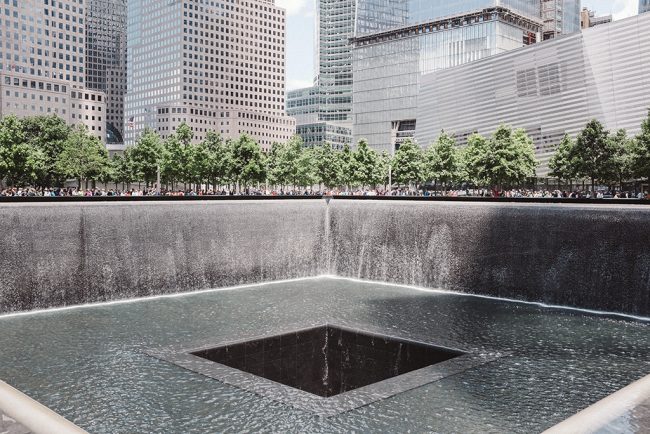
9/11 Memorial and Museum | Photo by Jonathan Percy
The most recent mass violent trauma suffered in New York City itself was not a battle, but the terrorist attacks on the World Trade Center in 2001. A dozen years later, The National September 11 Memorial & Museum is now open. Half of the World Trade Center site is dedicated to a memorial, which consists primarily of reflecting pools built in the footprints of the two towers. The names of victims killed in the attacks are inscribed in bronze around the edge of the pools. The memorial preserves a space of trauma, like Battle Pass. At the same time, it is a commemorative space, like the Lakeside World War I Memorial.
The other half of the World Trade Center site is a museum, whose hefty admission price and uses have provoked significant controversy and debate, in part due to the presence of the remains of unidentified victims that are housed in a repository at the site. Testing performed by a Western Connecticut State University archeology professor in 2000 indicated that human remains are also still present in the vicinity of Battle Pass — which is not surprising considering human remains were unearthed during the construction of the park, and a clear internment or preservation plan never materialized. But the likely presence of human remains under a site that thousands of people use daily for recreation has not caused the same outrage as, for example, VIP cocktail parties hosted in the 9/11 museum. Eventually, trauma becomes history. In the meantime, the public needs a space where they can process their grief.
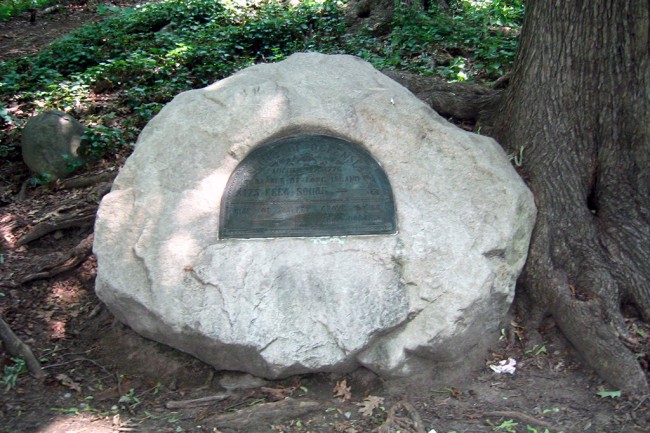
Line of Defense Marker | Photo by Wally Gobetz
Olmsted and Vaux’s intention for Battle Pass — topographical preservation, without an ornate memorial — contrasts with commemorations of wars fought beyond the borders of Brooklyn, like the Civil War memorial arch in Grand Army Plaza or the WWI memorial at Lakeside. The Battle Pass approach allows for more open-ended interpretations of history than these nationalistic monuments, but the simplicity of Battle Pass dissatisfied future generations, and more visible memorials were added to supplement Olmsted and Vaux’s memorialization by preservation. Their intention, to imbue an active public space with historical memory, is perhaps too understated to confront our collective propensity to forget. Still, Battle Pass can serve as a prompt to consider how to keep sites of historical memory in the public sphere. If we seek to remember through monumentality, yet fear entrusting our monuments to the private or commercial sphere, we must consider what it means to preserve and act as stewards for our collective history.
The views expressed here are those of the authors only and do not reflect the position of The Architectural League of New York.
Comments